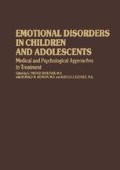Abstract
In view of the obvious importance of the ability to function effectively in school, it is quite unfortunate that year after year, for varied and sundry reasons, so many children experience some type of learning disorder. Probably the single most immediate reason for a youngster’s being referred to child psychiatric clinics, child guidance clinics, and child therapists is difficulty in school. Unfortunately, all too often the child is viewed with a kind of tunnel vision, so that extremely important aspects of his unique learning disorder may be ignored. The child is a physical organism functioning in a social environment in a psychological manner. Therefore, it is naive to think of one single cause for learning disabilities. Rather, learning problems are caused by any number of factors, all of which may be highly interrelated.
Access this chapter
Tax calculation will be finalised at checkout
Purchases are for personal use only
Preview
Unable to display preview. Download preview PDF.
References
Abrams, J.C. (1968) The role of personality defenses in reading. In G. Natchez, ed., Children with Reading Problems. New York: Basic Books.
Abrams, J.C. (1970) Learning disabilities—A complex phenomenon. Reading Teacher 23(4):299–303.
Abrams, J.C. (1971) Emotional resistances to reading. J. Reading Specialist 10(4): 191–196.
Abrams, J.C. (1975) Minimal brain dysfunction and dyslexia. Reading World 14:219–227.
Abrams, J.C. (in press) A psychodynamic understanding of the emotional spects of learning disorders. In B. Keogh, ed., Advances in Special Education. Greenwich, Conn.: Jai Press.
Abrams, J.C, and F. Kaslow. (1976) Learning disability and family dynamics: A mutual interaction. J. Clin. Child Psychol. 5:35–40.
Abrams, J.C, and F. Kaslow. (1977) Family systems and the learning disabled child: Intervention and treatment. J. Learning Disabilities 10(2):27—31.
Abrams, J.C, and W. Smolen. (1973) On stress, failure, and reading disability. J. Reading 16:462–466.
Adamson, W. (1978) Questions, definitions, and perspectives. In W. Adamson and K. Adamson, eds., A Handbook for Specific Learning Disabilities. New York: Gardner Press.
Bateman, B. (1965) An educator’s view of a diagnostic approach to learning disorders. In J. Hellmuth, ed., Learning Disorders, Vol. 1 Seattle: Special Child Publications.
Belmont, H.S. (1964) Psychological influences in learning. In Sociological and Psychological Factors in Reading. Philadelphia: Temple University Press. Bender Visual-Motor-Gestalt Test. (1938) New York: Psychological Corporation.
Decker, R.J. (1964) Manifestations of the brain damage syndrome in historical and psychological data. In S.R. Rappaport, ed., Childhood Aphasia and Brain Damage: A Definition. Narberth, Pa.: Livingston. Detroit Tests of Learning Aptitude. (1941) Indianapolis, Ind.: Test Division of Bobbs-Merrill.
Frostig, M. (1963) Frostig Developmental Test of Visual Perception. Consulting Psychologists Press. Gates Associative Learning Tests. (1928) Philadelphia: Reading Clinic. Temple University.
Gever, B. (1970) Failure and learning disability. Reading Teacher 23(4):3\ 1-317.
Hinshelwood, J. (1917) Congenital Word Blindness. London: H.K. Lewis. Key Math Diagnostic Arithmetic Test. (1971) Circle Pines, Minn.: American Guidance Service.
Kirk, S.A. (1962) Educating Exceptional Children. Boston: Houghton Mifflin.
Kirk, S.A., and W.D. Kirk. (1971) Psycholinguistic Learning Disabilities: Diagnosis and Remediation. Urbana, Ill.: University of Illinois Press.
Kirk, S.A., J.J. McCarthy, and W.D. Kirk. (1968) Illinois Test of Psycholinguistic Abilities, rev. ed. Urbana, Ill.: University of Illinois Press.
National Advisory Committee on Handicapped Children. (1968) Special Education for Handicapped Children, First Annual Report. Washington, D.C.: U.S. Department of Health, Education and Welfare, January 31, 1968.
Pasamanick, B., and H. Knobloch. (1961) Epidemiologic studies on the complications of pregnancy and the birth process. In G. Caplan, ed., Prevention of Mental Disorders in Childhood. New York: Basic Books. Peabody Individual Achievement Test. (1970) Circle Pines, Minn.: American Guidance Service.
Pearson, G.H.J. (1954) Psychoanalysis and the Education of the Child. New York: Norton.
Pikulski, J. (1978) Factors related to reading problems. In R. Stauffer, J.C Abrams, and J. Pikulski, eds., Diagnosis, Corrections, and Prevention of Reading Disabilities. New York: Harper & Row.
Rabinovitch, R. (1962) Dyslexia: Psychiatric considerations. In J. Money, ed., Reading Disability: Progress and Research Needs in Dyslexia. Baltimore: Johns Hopkins University Press.
Rapaport, D. (1946) Diagnostic Psychological Testing. Chicago: Yearbook Publishers.
Rappaport, S.R. (1961) Behavior disorder and ego development in a brain-injured child. Psychoanal. Study Child 16:423–450.
Rappaport, S.R., ed. (1964) Childhood Aphasia and Brain Damage: A Definition. Narberth, Pa.: Livingston. Recommendations of the Joint Committee on Learning Disabilities. (1976) Unpublished.
Stauffer, R., J.C. Abrams, and J. Pikulski. (1978) Diagnosis, Corrections and Prevention of Reading Disabilities. New York: Harper & Row. Van Wagenen Reading Readiness Test. (1938)
Minneapolis: Van Wagenen Psycho-Educational Research Laboratories, University of Minnesota. Waldman, M. (1970) Psychodynamics and educational orientation in the special school. Reading Teacher 23(4):325–330.
Waldman, M. (1971) Adjunctive programming for special education teacher. Unpublished. Wechsler Memory Scale. (1942) New York: Psychological Corporation.
Wessel, K. (1979) A prospective study of the relationship between the type of delivery and the use of medication and learning disabilities and ego disturbances in children. Unpublished doctoral dissertation. Wide Range Achievement Test, rev. ed. (1965) Wilmington, Del.: Guidance Associates.
Editor information
Editors and Affiliations
Rights and permissions
Copyright information
© 1980 Spectrum Publications, Inc.
About this chapter
Cite this chapter
Abrams, J.C. (1980). Learning Disabilities. In: Sholevar, G.P., Benson, R.M., Blinder, B.J. (eds) Emotional Disorders in Children and Adolescents. Child Behavior and Development. Springer, Dordrecht. https://doi.org/10.1007/978-94-011-6684-3_28
Download citation
DOI: https://doi.org/10.1007/978-94-011-6684-3_28
Publisher Name: Springer, Dordrecht
Print ISBN: 978-94-011-6686-7
Online ISBN: 978-94-011-6684-3
eBook Packages: Springer Book Archive

